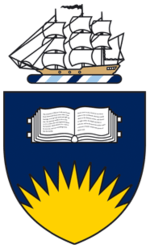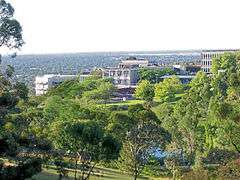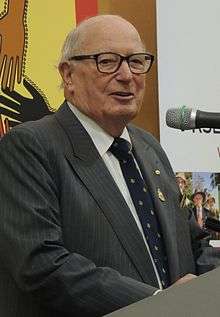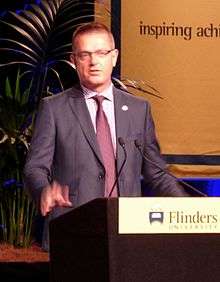Flinders University
 | |
| Motto | "Inspiring Achievement" |
|---|---|
| Type | Public |
| Established | 1966 |
| Chancellor | Stephen Gerlach AM |
| Vice-Chancellor | Colin Stirling |
Administrative staff | 1129 (2013) |
| Students | 26,078 (2014) |
| Location |
Bedford Park, South Australia, Australia 35°01′15″S 138°34′22″E / 35.020819°S 138.57275°E |
| Campus | Suburban |
| Organisations | IRU Australia |
| Website | www.flinders.edu.au |
 | |

Flinders University is a public university in Adelaide, South Australia. Founded in 1966, it was named in honour of navigator Matthew Flinders, who explored and surveyed the South Australian coastline in the early 19th century.
Flinders is a verdant university and a member of the Innovative Research Universities (IRU) Group[1] and ranks in the 10-16 bracket in Australia[2] and 36th in the world of those established less than 50 years. Academically, the university pioneered a cross-disciplinary approach to education, and its faculties of medicine and the humanities are ranked among the nation's top 10.[3]
The university is ranked within the world's top 400 institutions in the Academic Ranking of World Universities.[4] The latest Times Higher Education rankings of the world’s top universities ranks Flinders University in the 251 to 300 bracket.[5]
History
Origins and construction
By the late 1950s, the University of Adelaide's North Terrace campus was approaching capacity. In 1960, Premier Thomas Playford announced that 150 hectares (370 acres) of state government-owned land in Burbank (now Bedford Park) would be allocated to the University of Adelaide for the establishment of a second campus.[6]
Planning began in 1961. The principal-designate of the new campus, economist and professor Peter Karmel, was adamant that the new campus should operate independently from the North Terrace campus. He hoped that the Bedford Park campus would be free to innovate and not be bound by tradition.[6]
Capital works began in 1962 with a grant of ₤3.8 million from the Australian Universities Commission. Architect Geoff Harrison, in conjunction with architectural firm Hassell, McConnell and Partners, designed a new university that, with future expansions, could eventually accommodate up to 6000 students.[6]
Independence and opening
In 1965, the Australian Labor Party won the state election and Frank Walsh became premier. The ALP wished to break up the University of Adelaide's hegemony over tertiary education in the state, and announced that they intended the Bedford Park campus to be an independent institution.[6]
On 17 March 1966, a bill was passed by state parliament officially creating the Flinders University of South Australia.[7] Although the Labor Party had favoured the name "University of South Australia", academic staff wished that the university be named after a "distinguished but uncontroversial" person. They settled upon British navigator Matthew Flinders, who explored and surveyed the South Australian coastline in 1802. Its coat of arms, designed by a professor in the Fine Arts faculty, includes a reproduction of Flinders' ship Investigator and his journal A Voyage to Terra Australis, open to the page in which Flinders described the coast adjacent the campus site.[6]
Flinders University was opened by Her Majesty Queen Elizabeth, the Queen Mother, on 25 March 1966.[7] Peter Karmel was the first Vice-Chancellor and Sir Mark Mitchell the first Chancellor. The university began classes on 7 March 1966 with a student enrollment of 400.
A significant early initiative was the decision to build the Flinders Medical Centre on land adjacent to the campus and to base the university's Medical School within this new public hospital - the first such integration in Australia. Flinders first accepted undergraduate medical students in 1974, with FMC being opened the following year.[7]
Expansion and restructuring
In 1990, the biggest building project on campus since the mid-1970s saw work commence on three new buildings - Law and Commerce; Engineering; and Information Science and Technology. Approval for the establishment of a School of Engineering was given in 1991 and degrees in Electrical and Electronic Engineering[8] and Biomedical Engineering[9] were established shortly afterwards.
In 1991, as part of a restructuring of higher education in South Australia, Flinders merged with the adjacent Sturt Campus of the former South Australian College of Advanced Education. In 1992 the present four-faculty structure was adopted with only a minor change to the School structure made in 2011.
In 1998, the Centre for Remote Health, a rural teaching hospital based in Alice Springs, was established jointly with the Northern Territory University (now Charles Darwin University). This was expanded further in 2011 with the establishment of the Northern Territory Medical Program.
Since 2000 the University has established new disciplines in areas including Physiotherapy, Occupational Therapy and more disciplines of Engineering.[10]
In 2015, the University opened a new campus at Tonsley,[11] the former site of the Mitsubishi Motors Australia plant in Southern Adelaide. This campus houses the University's School of Computer Science, Engineering and Mathematics, along with the Medical Device Research Institute, the Centre for Nanoscale Science and Technology and Flinders technology start-up company Re-Timer.[12]
Campuses
The University's main campus is in the Adelaide inner southern suburb of Bedford Park, about 12 km south of the Adelaide city centre.[13] The University also has a presence in Victoria Square in the centre of the city,[14] and Tonsley. It also maintains a number of external teaching facilities in regional South Australia, south-west Victoria and the Northern Territory. International students make up 10% of the on-campus student population and a number of offshore programmes are also offered, primarily in the Asia-Pacific region.
Organisation

Flinders University offers more than 160 undergraduate and postgraduate courses, as well as higher degree research supervision across all disciplines. Many courses use new information and communication technologies to supplement face-to-face teaching and provide flexible options.
Faculties and schools
- Faculty of Education, Humanities and Law[15]
- Faculty of Medicine, Nursing and Health Sciences[16]
- Faculty of Science and Engineering[17]
- Faculty of Social and Behavioural Sciences[18]
Chancellory


Flinders University has been served by six Chancellors and eight Vice Chancellors since its establishment in 1966. They are:[19]
| Name | Years | Position |
|---|---|---|
| Peter Karmel | 1966-1971 | Vice Chancellor |
| Mark Mitchell | 1966-1971 | Chancellor |
| Charles Hart Bright | 1971-1983 | Chancellor |
| Roger Russell | 1972-1979 | Vice Chancellor |
| Keith Hancock | 1980-1987 | Vice Chancellor |
| Francis Robert Fisher | 1983-1988 | Chancellor |
| John Lovering | 1987-1994 | Vice Chancellor |
| Deirdre Frances Jordan | 1988-2002 | Chancellor |
| Ian Chubb | 1995-2000 | Vice Chancellor |
| Anne Edwards AO | 2001-2007 | Vice Chancellor |
| Sir Eric Neal | 2002-2010 | Chancellor |
| Michael Barber | 2008-2014 | Vice Chancellor |
| Stephen Gerlach | 2010-present | Chancellor |
| Colin Stirling | 2015-present | Vice Chancellor |
Affiliates
- Australian Science and Mathematics School
- Flinders Medical Centre
- The Adelaide Theological Centre Inc (comprising the Catholic Theological College and the Uniting College for Leadership and Theology replacing the Adelaide College of Divinity)[20]
- Helpmann Academy
Academic profile
Rankings
| University rankings | |
|---|---|
| Flinders University | |
| QS World[21] | 551-600 |
| THE-WUR World[22] | 251-300 |
| ARWU World[23] | 300-400 |
| CWTS Leiden World[24] | 527 |
| Australian rankings | |
| CWTS Leiden National[24] | 18 |
| ERA National[25] | 28 |
The university is ranked within the world's top 400 institutions in the Academic Ranking of World Universities.[4] The latest Times Higher Education rankings of the world’s top universities ranks Flinders University in the 251 to 300 bracket.[26]
Student life
Housing
Flinders is the only South Australian university with on-campus accommodation in the Adelaide metropolitan area. There are two options:
- University Hall (catered)
- Deirdre Jordan Village (self-catered).
For off-campus accommodation, Flinders Housing run a free, up-to-date accommodation service which lists private accommodation available on the rental market.
Media
The Empire Times was published by the Students' Association of Flinders University (SAFU) from 1969 to 2006. The founder and first editor of the newspaper was Martin Fabinyi, and the newspaper was originally printed in the back of his house by fellow student Rod Boswell. Empire Times had a history of controversial humour and anti-establishment discussion. Notable former editors and contributors included Martin Armiger and Greig (HG Nelson) Pickhaver, Steph Key and Kate Ellis. Empire Times ceased publication in 2006 as a result of voluntary student unionism, but resumed in 2013.
The newly formed student organisation, Flinders One, launched Libertine Magazine in 2008. It was published quarterly at the beginning of each term. Libertine was contributed to by students across the Flinders community and features articles, a feature artist, columns, creative writing, and a rant in each edition. It was partially funded by outside advertising, which was liaised through Flinders One. Libertine Magazine finished printing at the end of 2011 after the 2011 Student Council decided to revamp it.
A Media Group was established by the Student Council. After the SSAF passed in 2012, more money was available for Student Media.
Empire Times has been revived in 2013 by the Flinders University Student Association. Empire Times releases 10 issues over the academic year. The 2016 Editorial team consists of Liam McNally, Eleanor Danenberg, and Lauren Reid.
Sports
Flinders University has many sports teams that compete in social and competitive competitions. Flinders University also fields a baseball side in the Division 5 and Division 6 levels of the South Australian Baseball League.
Distinguished alumni and persons
Entertainment and the arts
- Mario Andreacchio - film director and producer
- Benedict Andrews - theatre director
- Alex Frayne - film director
- Noni Hazlehurst - actress
- Scott Hicks - film director
- Victoria Hill - actress, writer and producer
- Aimee Horne - actress and singer
- Craig Lahiff - film director
- Nina Landis - actress
- Caleb Lewis - playwright
- Sam Mac - radio and television personality
- Anthony Maras - film director, writer and producer
- Doc Neeson - singer, songwriter and front man of The Angels
- Gian Carlo Petraccaro - film director
- Greig Pickhaver (also known as H.G. Nelson) - actor, comedian and writer
- Xavier Samuel - actor
- John Schumann - Michael Atkinson, Verity Truman, Chris Timms (founding members of Redgum)
- Wendy Strehlow - actress
- Eddie White - animation writer and director
Humanities
- Jack Barbalet - professor of sociology
- Carl Bridge - professor of history at King's College, London
- Marion Maddox - author and professor of history at Macquarie University
- Haydon Manning - political scientist
- Wesley Wildman - professor of theology at Boston University
Politics
- John Bannon - former South Australian Premier
- Zoe Bettison - South Australian state politician and Minister
- Susan Close - South Australian state politician and Minister
- David Cox - Member of the Australian House of Representatives
- Kate Ellis - Member of the Australian House of Representatives and Minister
- Bronwyn Halfpenny - Member of the Victorian Legislative Assembly
- Ian Hunter - South Australian state politician and Minister
- Tom Kenyon - South Australian state politician and Minister
- Stephanie Key - South Australian state politician and Minister
- Jenny Leong - Member of the New South Wales Legislative Assembly
- Brendan Nelson - former Australian Leader of the Opposition
- Chris Picton - South Australian state politician
- Mike Rann - former Premier, appointed as a Flinders University professor
- Amanda Rishworth - Member of the Australian House of Representatives
- Don Russell - former Australian Ambassador to the United States
- Robert Simms - Australian Senator
- Andrew Southcott - Member of the Australian House of Representatives
- Gayle Tierney - Member of the Victorian Legislative Council
- Sialeʻataonga Tuʻivakanō - Prime Minister of Tonga[27]
- Lynne Walker - Northern Territory Deputy Leader of the Opposition
Science and mathematics
- Philip Bourne - professor of pharmacology at UCSD
- Rodney Brooks - professor of robotics at MIT
- Brendon Coventry - discovered the immune cycle, cancer pioneer
- Sabine Dittmann - marine biologist
- Mohammad Kaykobad - Computer Scientist, Professor of CSE, BUET
- Mamoru Mohri - retired astronaut, scientist and engineer
- Terence Tao - Fields Medalist, professor of mathematics at University of California Los Angeles
- Anthony William Thomas - professor physics at Adelaide University
Sport
- Matthew Liptak - Adelaide Crows footballer
- Agnes Milowka - technical diver and author
Writers
- Sudesh Mishra - poet
- Christopher Pearson - journalist, founder of the Adelaide Review and speechwriter for former Prime Minister John Howard
- Mark Peel - Australian historian
- Petar Pjesivac - Serbian poet and essayist
To date, Flinders has produced four Rhodes scholars.[28]
See also
References
- ↑ Innovative Research Universities, http://www.irua.edu.au
- ↑ http://www.shanghairanking.com/Country2012Main.jsp?param=Australia
- ↑ Ross Williams; Nina Van Dyke (November 2006). "Rating Major Disciplines in Australian Universities: Perceptions and Reality" (PDF). Melbourne Institute, University of Melbourne. Archived from the original (PDF) on 2008-06-27. Retrieved 2008-09-12.
- 1 2 "Academic Ranking of World Universities 2013". Shanghai Jiao Tong University. Retrieved 11 November 2013.
- ↑ http://blogs.flinders.edu.au/flinders-news/2015/10/01/flinders-rises-to-top-300-in-world-rankings/
- 1 2 3 4 5 http://www.flinders.edu.au:80/about/our-university/our-history/1958---1965-from-the-ground-up.cfm Flinders University - 1958-1965: From the ground up
- 1 2 3 http://www.flinders.edu.au:80/about/our-university/our-history/1966---1971-the-first-students.cfm Flinders University - 1966-1971: The first students
- ↑ "Electrical and Electronic Engineering". Retrieved 15 July 2015.
- ↑ "Biomedical Engineering". Retrieved 15 July 2015.
- ↑ "Mechanical Engineering". Retrieved 15 July 2015.
- ↑ "Flinders Future Focus". Flinders Future Focus. Retrieved 2016-01-21.
- ↑ Macfarlane, Ian. "Flinders' Tonsley campus links students, research and business". Ministers for the Department of Industry and Science. Retrieved 2016-01-21.
- ↑ Location and getting to Flinders, http://www.flinders.edu.au
- ↑ Flinders in the City, http://www.flinders.edu.au
- ↑ "Home Page - Flinders University". Retrieved 15 July 2015.
- ↑ "Health Sciences - Flinders University". Flinders.edu.au. 22 September 2010. Retrieved 2010-09-26.
- ↑ "Science & Engineering - Home Page - Flinders University". Scieng.flinders.edu.au. 22 September 2010. Retrieved 2010-09-26.
- ↑ "Social and Behavioural Sciences - Flinders University". Flinders.edu.au. 22 September 2010. Retrieved 2010-09-26.
- ↑ "Flinders University". www.flinders.edu.au. Retrieved 2016-04-18.
- ↑ About_ACD accessed 7 June 2011
- ↑ "QS World University Rankings 2016/17". Quacquarelli Symonds Limited.
- ↑ "World University Rankings 2016-2017". TSL Education Limited.
- ↑ "Academic Ranking of World Universities 2016". Shanghai Ranking Consultancy.
- 1 2 "CWTS Leiden Ranking 2016". Centre for Science and Technology Studies, Leiden University.
- ↑ "Australian University Rankings". Australian Education Network.
- ↑ http://blogs.flinders.edu.au/flinders-news/2015/10/01/flinders-rises-to-top-300-in-world-rankings/
- ↑ "Tu'ivakano became Prime Minister Designate". Matangi Tonga. 21 December 2010. Retrieved 2010-12-21.
- ↑ "Great results rewarded with Rhodes Scholarship". 16 October 2009.
External links
| Wikisource has original text related to this article: |
| Wikimedia Commons has media related to Flinders University. |
- Affiliated teaching bodies
- Australian Science and Mathematics School
- Flinders Medical Centre
- Adelaide Central School of Art
- Helpmann Academy
- Institutional affiliations